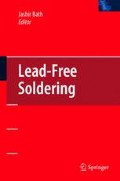Printed wiring board manufacturing yields and subsequent product reliability are significantly impacted by the properties and characteristics of the laminate materials used. The selection of laminate materials is more critical for achieving higher temperature lead-free solder alloy assembly yield targets and long term product reliability requirements. The SAC305 tin-silvercopper alloy (3.0 percent silver and 0.5 percent copper) recommended for lead-free assembly reflow processing and rework has a melting point about 40°C higher than the melting point of eutectic tin-lead.
Access this chapter
Tax calculation will be finalised at checkout
Purchases are for personal use only
Preview
Unable to display preview. Download preview PDF.
References
Baggio T, Suetsugu K (1999) Guidelines for Lead-Free Processing, SMT magazine
Davignon J, Reed R (2000) Effects of NEMI Sn/Ag/Cu Alloy Assembly Reflow on Plated Through Hole Performance, NEPCON East Conference, Boston, USA
Smetana J (2002) Plated Through Hole Reliability with High Temperature Lead-Free Soldering, The Board Authority magazine
Leys D, Schaefer S (2003) PWB Dielectric Substrates for Lead-Free Electronics Manufacturing, CircuiTree magazine
Turbini L, Bent W, Ready W, Impact of Higher Melting Lead-Free Solders on the Reliability of Printed Wiring Assemblies, Center for Microelectronics Assembly and Packaging, University of Toronto, Toronto, Canada, and Georgia Institute of Technology, Atlanta, USA
Engelmaier W (2003) Reliability of Lead-Free Solder Joints Revisited, Global SMT & Packaging, p. 34
Wolf D (2003) Delphi Reliability Study, IPC PCQR2/CAT
Smetana J (2006) Via (PTH) Integrity with Lead Free Soldering, IPC PC EXPO-APEX conference, Anaheim, USA, S24; http://www.hdpug.org/public/4-papers/apex-2006/via-integrity-paper.pdf
Author information
Authors and Affiliations
Editor information
Editors and Affiliations
Rights and permissions
Copyright information
© 2007 Springer Science+Business Media, LLC
About this chapter
Cite this chapter
Sr, K.S. (2007). PCB Laminates. In: Bath, J. (eds) Lead-Free Soldering. Springer, Boston, MA. https://doi.org/10.1007/978-0-387-68422-2_8
Download citation
DOI: https://doi.org/10.1007/978-0-387-68422-2_8
Publisher Name: Springer, Boston, MA
Print ISBN: 978-0-387-32466-1
Online ISBN: 978-0-387-68422-2
eBook Packages: EngineeringEngineering (R0)

